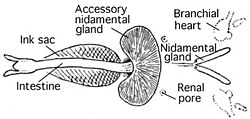Branchial heart
Appearance

Branchial hearts are accessory pumps that supplement the action of the
myogenic in nature.[1] Branchial hearts are always in pairs located at the base of the gills. Each branchial heart consists of a single chamber.[1][2] They pump blood through the gills via the afferent branchial veins. Since they only circulate venous blood, branchial hearts function under predominantly anaerobic conditions.[1] Branchial hearts also appear to be involved in hemocyanin synthesis.[3][2]
Each branchial heart is directly connected to a branchial heart appendage or pericardial gland.[4] The action of the branchial hearts is necessary for the production of primary urine in these appendages via pressure filtration.[5] Branchial hearts may have evolved from the pericardial glands of nautiloids, such as those still found in modern nautiluses.[6]



